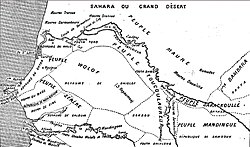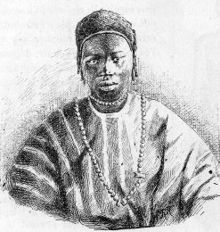
Senegal, officially the Republic of Senegal, is the westernmost country in continental Africa, situated on the Atlantic Ocean coastline. Senegal is bordered by Mauritania to the north, Mali to the east, Guinea to the southeast and Guinea-Bissau to the southwest. Senegal nearly surrounds The Gambia, a country occupying a narrow sliver of land along the banks of the Gambia River, which separates Senegal's southern region of Casamance from the rest of the country. Senegal also shares a maritime border with Cape Verde. Senegal's economic and political capital is Dakar.
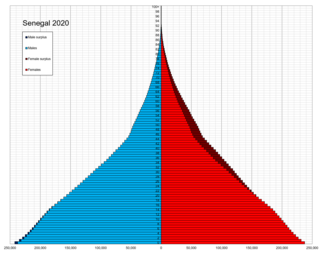
Demographic features of the population of Senegal include population density, ethnicity, education level, health of the populace, economic status, religious affiliations and other aspects of the population.

The West Atlantic languages of West Africa are a major subgroup of the Niger–Congo languages.
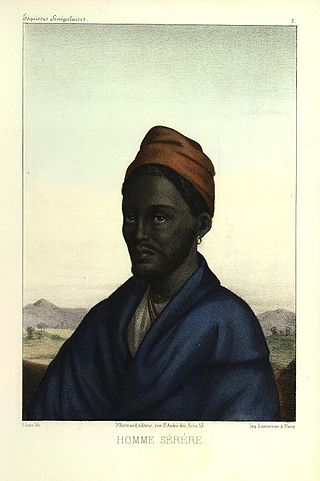
The Serer-Ndut or Ndut also spelt are an ethnic group in Senegal numbering 38600. They are part of the Serer people who collectively make up the third largest ethnic group in Senegal. The Serer-Ndut live mostly in central Senegal in the district of Mont-Roland, northwest of the city of ancient Thiès.

Senegal's music is best known abroad due to the popularity of mbalax, a development of conservative music from different ethnic groups and sabar drumming popularized internationally by Youssou N'Dour.
The Senegambia is, in the narrow sense, a historical name for a geographical region in West Africa, which lies between the Senegal River in the north and the Gambia River in the south. However, there are also text sources which state that Senegambia is understood in a broader sense and equated with the term the Western region. This refers to the coastal areas between Senegal and Sierra Leone, where the inland border in the east was not further defined.

The Mandinka or Malinke are a West African ethnic group primarily found in southern Mali, the Gambia, southern Senegal and eastern Guinea. Numbering about 11 million, they are the largest subgroup of the Mandé peoples and one of the largest ethnic-linguistic groups in Africa. They speak the Manding languages in the Mande language family, which are a lingua franca in much of West Africa. Virtually all of Mandinka people are adherent to Islam, mostly based on the Maliki jurisprudence. They are predominantly subsistence farmers and live in rural villages. Their largest urban center is Bamako, the capital of Mali.

The music of the Gambia is closely linked musically with that of its neighbor, Senegal, which surrounds its inland frontiers completely. Among its prominent musicians is Foday Musa Suso. Mbalax is a widely known popular dance music of the Gambia and neighbouring Senegal. It fuses popular Western music and dance, with sabar, the traditional drumming and dance music of the Wolof and Serer people.

The Toucouleur people or Tukulor people, also called Haalpulaar, are a West African ethnic group native to the Futa Toro region of Senegal. There are smaller communities in Mali and Mauritania. The Toucouleur were Islamized in the 11th century; their early and strong Islamic heritage, which is seen as a defining feature, is a "matter of great pride for them". They were among the first Muslims in the area that became Senegal. They were influential in the spread of Islam to West Africa in the medieval era.

The Wolof, the largest ethnic group in Senegal, have a distinctive musical tradition that, along with the influence of neighboring Fulani, Tukulor, Serer, Jola, and Malinke cultures, has contributed greatly to popular Senegalese music, and to West African music in general. Wolof music takes its roots from the Serer musical tradition, particularly from the Serer pre-colonial Kingdom of Saloum. Virtually all Wolof musical terminology including musical instruments comes from the Serer language.

The Jola or Diola are an ethnic group found in Senegal, the Gambia, and Guinea-Bissau. Most Jola live in small villages scattered throughout Senegal, especially in the Lower Casamance region. The main dialect of the Jola language, Fogni, is one of the six national languages of Senegal.

Senegal is a multilingual country: Ethnologue lists 36 languages, Wolof being the most widely spoken language.
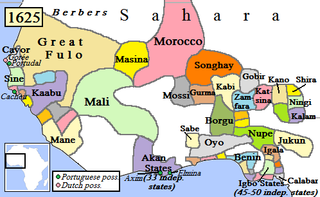
Kaabu (1537–1867), also written Gabu, Ngabou, and N'Gabu, was a federation of Mandinka kingdoms in the Senegambia region centered within modern northeastern Guinea-Bissau, large parts of today's Gambia, and extending into Koussanar, Koumpentoum, and the Casamance in Senegal.
Daniel Laemouahuma Jatta is a Jola scholar and musician from Mandinary, Gambia, who pioneered the research and documentation of the akonting, a Jola folk lute, as well as the related Manjago folk lute, the buchundu, in the mid-1980s. Prior to Jatta's work, these instruments were largely unknown outside the rural villages of the Senegambia region of West Africa.

The Serer people are a West African ethnoreligious group. They are the third-largest ethnic group in Senegal, making up 15% of the Senegalese population. They are also found in northern Gambia and southern Mauritania.
The French conquest of Senegal started in 1659 with the establishment of Saint-Louis, Senegal, followed by the French capture of the island of Gorée from the Dutch in 1677, but would only become a full-scale campaign in the 19th century.

The medieval history of the Serer people of Senegambia is partly characterised by resisting Islamization from perhaps the 11th century during the Almoravid movement, to the 19th century Marabout movement of Senegambia and continuation of the old Serer paternal dynasties.
Babacar Sedikh Diouf or Babacar Sédikh Diouf is a Senegalese historian, author, researcher, campaigner against "Wolofization", a Pan-Africanist, and former teacher. He has written extensively about the history and culture of Senegal, Africa, and that of the Serer ethnic group to which he belongs. He usually writes by the pen name Babacar Sedikh Diouf.
Wolofization or Wolofisation is a cultural and language shift whereby populations or states adopt Wolof language or culture, such as in the Senegambia region. In Senegal, Wolof is a lingua franca The Wolofization phenomenon has taken over all facets of Senegal and encroaching on Gambian soil. This phenomenon has caused other Senegambian ethnic groups great concern and resulted in taking steps to preserve their languages and culture. In this regard, the Serer ethnic group who have had a long history fighting against Islamization and Wolofization have been taking active steps in the past decades by setting up associations and other organisations in order to preserve their languages, culture and "ancient religious past." Haalpulaar speakers, namely the Fula and Toucouleur have also been taking steps to preserve their language.
